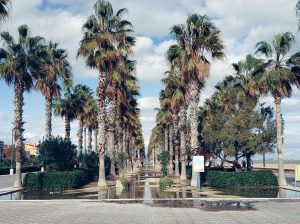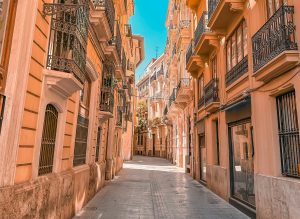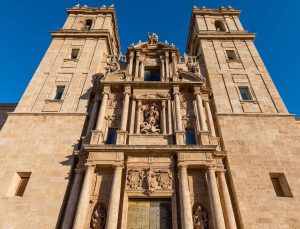1. Plaza de la Reina Valencia
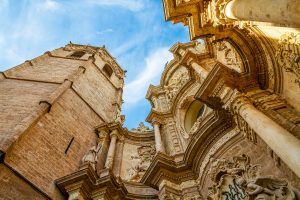
This lively square serves as the centerpiece of Valencia’s historic district. Visitors flock here to admire stunning architecture, soak in the atmosphere of a centuries-old café, and browse through artisan markets.
Situated at the heart of Valencia’s historic center, Plaza de la Reina boasts a wealth of historical landmarks, seasonal craft markets, and a diverse array of cafes and restaurants, many offering outdoor seating. Considered by many as the unofficial gateway to Valencia, this square exudes charm and history.
As you arrive at the square, your attention will be drawn to the majestic Valencia Cathedral, which dominates the northern section. Originally built in the 13th century on the site of an ancient mosque, the cathedral showcases an impressive blend of Baroque, Gothic, and Romanesque architectural styles.
Visitors can enhance their experience by renting an audio guide for a self-guided tour, viewing a chalice believed by some to be the Holy Grail. For panoramic views of Valencia’s skyline, climb the spiral staircase to the summit of the Miguelete bell tower.
Conveniently located within walking distance of Valencia’s main attractions, including the Central Market and the Plaza de la Virgen, Plaza de la Reina also offers easy access via public buses, with a designated stop within the square. For those traveling by car, underground parking facilities are available for a fee beneath the square.
2. Mercado Central de Valencia
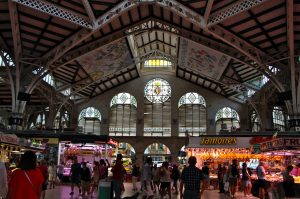
If you have a passion for gastronomy and appreciate the freshness, color, and flavor of quality cuisine, the Central Market of Valencia is a destination you can’t afford to miss.
This sprawling market, housed within a magnificent modernist building, offers a cornucopia of fresh produce straight from the orchards, infused with the essence of the Mediterranean. Take a leisurely stroll through the market; your senses will be delighted!
As the largest fresh produce market in Europe, the Central Market stands out not only for its diverse and abundant food offerings but also for its stunning architectural features. The market is adorned with decorative motifs celebrating Valencia’s agricultural heritage.
Yet, it’s not just the aesthetics that captivate; the market exudes a vibrant atmosphere filled with vibrant colors, enticing aromas, and flavors that reflect the region’s rich culinary heritage. It’s a fusion of traditional market culture and the bustling energy of tourism, making it a popular destination for both locals and visitors alike.
The Central Market offers a tantalizing array of fresh fruits and vegetables, with oranges, tomatoes, and beans taking center stage.
In addition to produce, you’ll find a variety of meats, cheeses, seafood, spices, nuts, and much more. Whether you’re in search of ingredients for a gourmet meal or simply looking to immerse yourself in the vibrant atmosphere, the Central Market promises a magical experience that shouldn’t be missed.
3. Ruzafa neighborhood Valencia
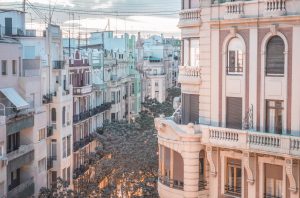
Ruzafa has undergone a significant transformation over the past decade. Not only has it become a hub for commerce and gastronomy, but it has also emerged as a vibrant center for culture and leisure.
Life in Ruzafa unfolds at a different pace, where long-time residents coexist with a youthful energy and a penchant for alternative trends, making it Valencia’s trendiest neighborhood.
Located just south of the historic center, Ruzafa is part of the Ensanche district and extends to Avenida Reino de Valencia. It still retains some of its historic charm, with landmarks like Ruzafa Market. The market’s vibrant exterior draws visitors in, while nearby terraces offer a popular spot for lunch.
Ruzafa’s gastronomic scene has been a driving force behind its popularity. Renowned chefs have chosen Ruzafa as the site for their most innovative restaurant ventures. The neighborhood also offers a diverse array of international cuisine.
4. Ciudad de las Artes y las Ciencias
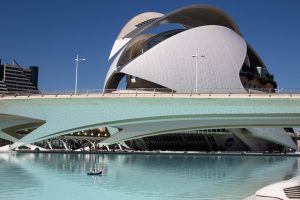
When visiting Valencia, a trip to the City of Arts and Sciences is essential. Several of its buildings have become iconic landmarks in the city. This scientific and cultural leisure complex sprawls across approximately two kilometers of the former riverbed of the River Turia, offering an enriching experience for families and friends alike.
To explore the City of Arts and Sciences, tickets are required for entry to the Hemisfèric, the Science Museum, and the Oceanogràfic. Tickets can be purchased separately or combined based on your preferences. It’s advisable to plan your visit in advance, as there is plenty to see and do.
Science Museum
The Science Museum encourages hands-on exploration with its interactive exhibitions on science and technology. Visitors are welcomed to the ground floor for temporary exhibitions, shops, amenities, and dining options without a ticket. Additional ticketing is required for access to the remaining exhibitions and scientific workshops.
Hemisfèric
Oceanogràfic
A visit to the Oceanogràfic, Europe’s largest aquarium, is a must-do in Valencia. Housing seven distinct marine environments, it showcases specimens representing 500 different species, including dolphins, belugas, walruses, sea lions, seals, penguins, and sharks. Don’t miss the daily exhibitions at the dolphinarium, and allocate at least half a day for your visit.
Umbracle
The Umbracle is a sprawling open-access garden spanning over 17,500 square meters, showcasing Mediterranean flora and contemporary sculptures. The public car park of the City of Arts and Sciences is conveniently located beneath the Umbracle.
L’Assut d’Or
The Assut d’Or Bridge spans the former riverbed of the River Turia, connecting the Science Museum and the Ágora. It features multiple traffic lanes in both directions and a pedestrian bridge at its center, linking the two banks of the Turia Garden.
Ágora / CaixaForum Valencia
The Ágora is home to CaixaForum Valencia, a versatile venue hosting temporary and permanent exhibits, live music, screenings, conferences, and shows, offering visitors a blend of culture and science.
Palau de les Arts
Music enthusiasts will appreciate the Palau de les Arts, which hosts a diverse program of operas, concerts, zarzuela, and ballet performances from October to November. Advance booking is required for visits when the venue is not in use for performances.
5. Parque natural de la Albufera, El Palmar
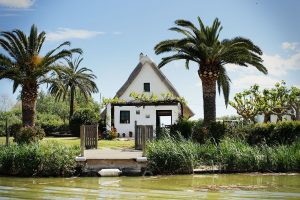
L’Albufera Natural Park, situated just 10 kilometers from the city, presents nature in its purest form, with enchanting sunsets, boat rides, and the chance to disconnect like nowhere else. Nestled amidst paddy fields and forests, it serves as an urban oasis, carrying particular importance for those acquainted with it. For anyone keen on delving into the origins of Valencian cuisine, a visit to this park is essential, as it stands as the birthplace of the iconic dish, paella.
Venture to the town of El Palmar to savor its traditional dishes. It’s a chance to appreciate food while learning about its roots. Explore one of the six designated routes through the nature reserve, where you can encounter various waterfowl and vegetation, and experience life as a local fisherman on Spain’s largest lagoon. It’s an experience that will surely beckon you to return.
The focal point of the park is the expansive freshwater lagoon, spanning over 3,000 hectares, making it the largest in Spain and giving the park its name, L’Albufera. Home to approximately 300 different bird species year-round, especially waterfowl during winter, including flamingos.
Surrounding the lagoon are marshes and rice fields, each phase of the agricultural cycle transforming the landscape—from vibrant green in summer to flooded blue fields in winter and bare brown earth in between. Along the coastal strip lies a unique ecosystem: the natural dunes and pine woods of La Devesa.
To reach the park, you can take EMT city buses 24 and 25 from the center of Valencia, each completing the journey to El Palmar and El Perellonet, respectively, in less than an hour for just €1.50 each way. Both buses are complimentary with the Valencia Tourist Card, or with other public transportation cards.
6. La Marina de Valencia
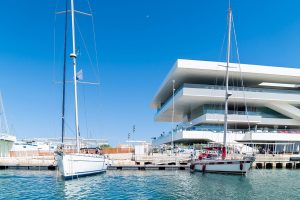
Valencia Marina, located between the city’s commercial port and the Seafront Promenade, represents modernity with its expansive spaces for walking, cycling, enjoying local cuisine, and participating in sports and nautical activities.
Developed during the modernization of the Port, this area seamlessly integrates culture, education, and commerce with sports, tourism, and gastronomy.
The iconic Veles e Vents serves as the focal point, functioning as a cultural center for exhibitions, live performances, conferences, and dining experiences. In close proximity, there are numerous restaurants, luxury hotels, and the Marina Beach Club providing entertainment late into the night.
Benefiting from a climate conducive to year-round sailing, the Marina is a haven for maritime activities, boasting moorings at competitive rates and offering comprehensive assistance services. With 40 nautical activity companies, six sports clubs, and three sports federations, visitors can partake in sailing, diving, kayaking, rowing, and even pilates. Boat rides provide a picturesque way to enjoy sunsets, dining, and onboard festivities.
7. Playa de la Malvarrosa


